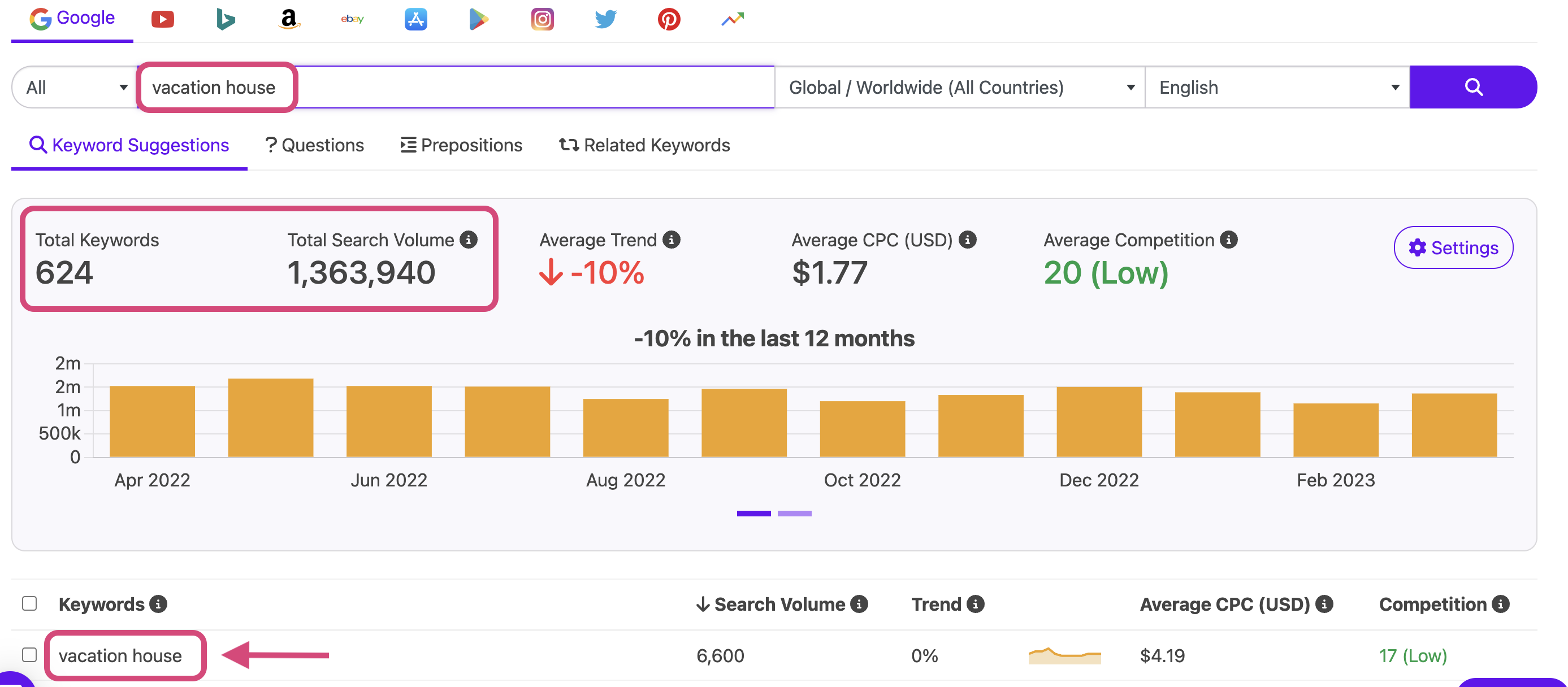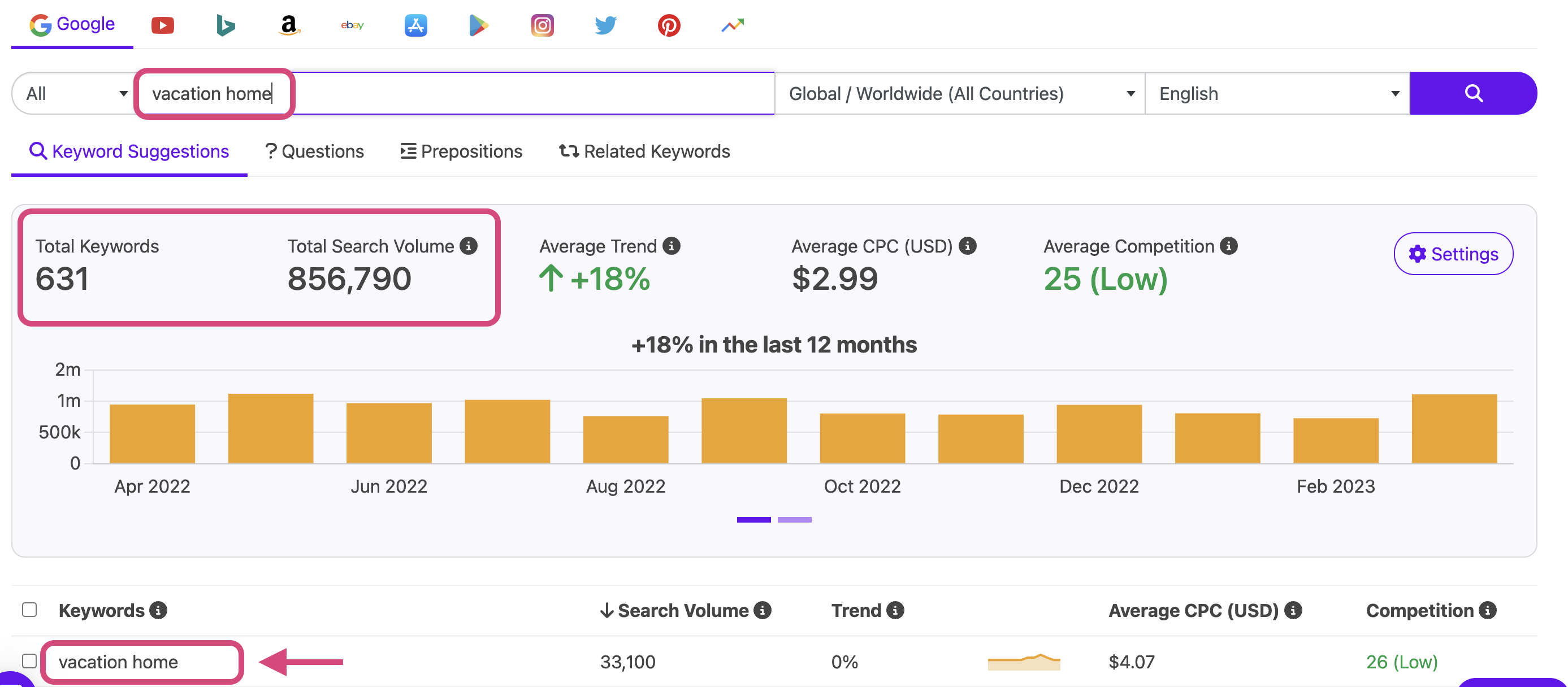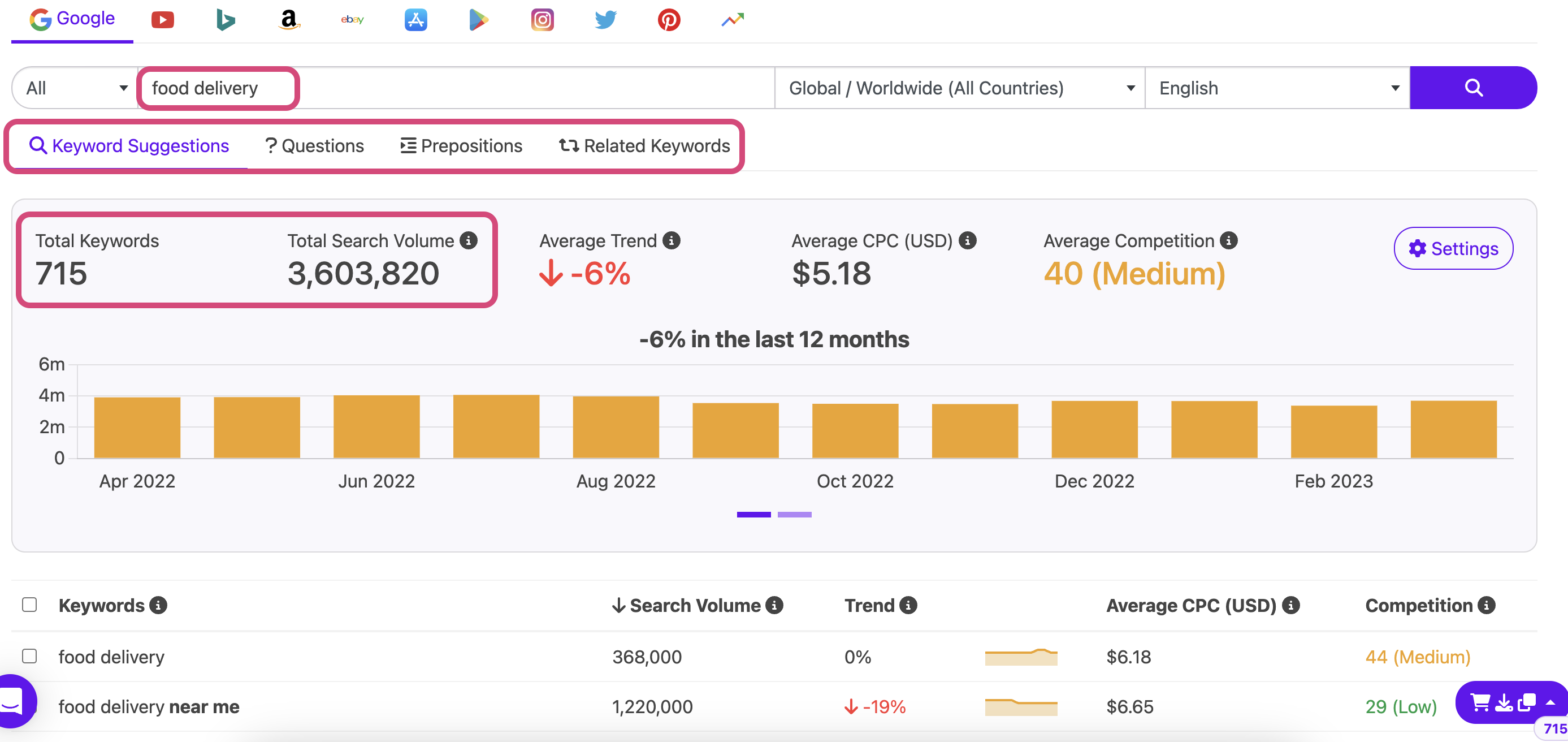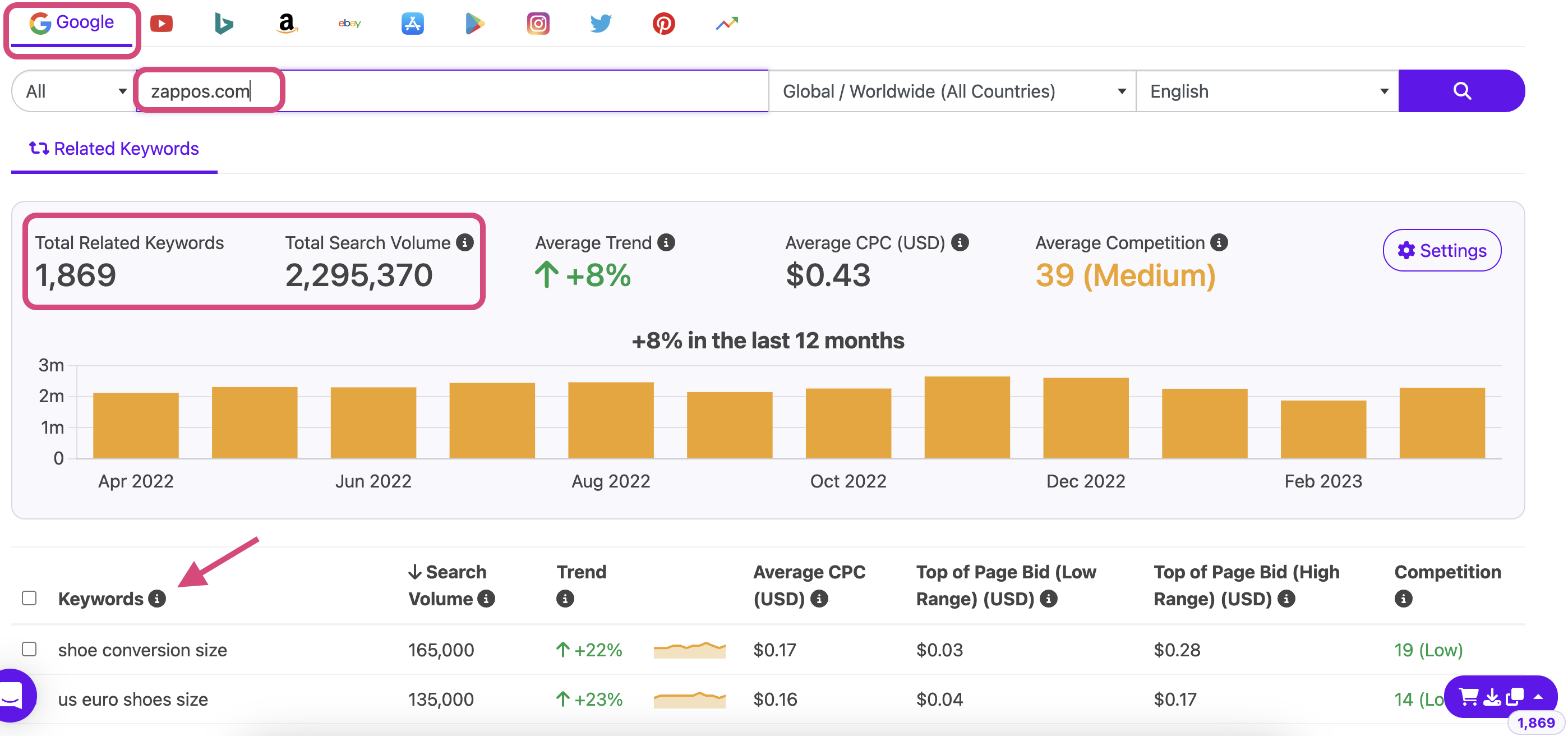Keyword Research: The Complete Guide to Find the Best Keywords
Keyword research is the first and most important part of your SEO strategy.
Before you start writing content for your website, you will need to identify suitable high-volume search terms.

The SEO keywords will inform the direction of your content, ensuring that the content produced will be relevant and easily searchable on Google. And that is, in summary, what keyword research is all about.
It’s usually a pretty time-consuming task and involves a lot of effort to pour through details, numbers, and comparing long lists of keywords. But it’s incredibly important to do it well. A thorough keyword research will be the foundation of your SEO strategy and content development.
What is keyword research?
Keyword research is defined as the activity of analyzing and finding a list of valuable keywords for the purpose of SEO copywriting. The keywords, or search terms, often become a guide for the direction of your content and marketing strategy.
A keyword can consist of a single word but more often than not it’s made out of several words. For example, “search terms” is a keyword, as is “best keyword search tool“.
Why is keyword research important?
Finding high-volume search terms itself is not enough. You need to ensure that the SEO keywords used in your content matches with your brand, product, or service to the keywords that your customer use. And this is where keyword research happens.
Once you have performed adequate and thorough research, only then will you be able to craft a viable SEO strategy. With a good strategy, you can then create a detailed plan of action to achieve your goals.
For example, if you are in the business of leasing out vacation homes, you may choose your focus keyword as “vacation house.” However, by doing a quick keyword research, we find out that the keyword ‘vacation home’ is much better to use in terms of search volume data.


Both terms might mean the same thing, but your target audience is searching for something different, as you can see above. Search volume for ‘vacation home’ is 33,100, whereas search volume for ‘vacation house’ is 6,600.
You would have never guessed the difference if not for keyword research.
Keywords that you choose to use should be those that your target audience is searching. Only then will it make the effort of optimizing your page worthwhile.
But more importantly, two similar keywords often have different search volumes, trends, and competition levels. Choosing a more relevant, higher volume keyword could give you better results compared to its other semantic or related keywords.
How to do keyword research
There are many ways to do it, either manually or using a keyword research tool like Keyword Tool. But whichever way you choose, there are a number of important steps that you need to take.
From outlining your goals to executing your keyword plan, follow these detailed step-by-step guide to performing a proper and thorough keyword research:
Step 1: Study your niche
Before you figure out what are the best keywords to optimize your page, it’s best that you start by diving deep to learn more about your topic or niche. It can give you out-of-the-box ideas and help discover angles to your marketing and SEO strategy that you might not have thought about before.
Here are a few ideas on how to study your niche:
- Talk with your existing customers and get to know them better. Find out the terms that they use when describing your brand, company, product or service.
- Try to think from the perspective of your potential customers. If you were to share the brand’s offering to a friend, how will you talk about it?
- Get involved in your topic or niche’s online communities, like forums and social media networks. Read the discussions and find out any pain points that are mentioned regarding your niche.
Step 2: Define your goals
A plan needs to always begin by defining the end goal. But before that, you should ask important and introspective questions like:
- Who are you?
- What is your brand about?
- What makes you special?
- What is your website about?
- What promises do you make on your website?
Once you have effectively answered these questions, then you need to specify what is your brand’s mission. Do you want to increase the number of subscribers? Or do you have a sales target by a certain date?
It’s important to define your goal because it will provide a direction for your SEO strategy and plan. The search terms that you will eventually use should be aligned to your goals, ideally segmented into different content marketing funnels. Your goals will also inform the purpose of your SEO copywriting and content.
Write down your goals. Draw charts. Document them. These will provide the framework and direction needed for your top-level content and online marketing strategy.

Step 3: Make a list of relevant topics
Based on your the main category of your brand and the goals you aim to achieve, break it down to smaller topic buckets. Make a list of all the topics related to your brand that you want to rank on Google.
For example, if you’re an FMCG brand specializing in men’s personal care products, some topics that are related to your brand can be:
- men’s facial wash
- antiperspirant deodorant
- male pattern baldness
They need to be topics that are important to your business and related to your buyer personas. Think about what type of topics will your target audience search for on Google? These topic buckets can then later be broken down to keywords that are related to those topics.
Step 4: Create a list of seed keywords
Now that you’ve broken down your main category to different buckets of sub-topics, you can start creating a list of seed keywords. These keywords need to be related to your various topics, and more importantly, are terms that your target audience might be searching on Google.
Seed keywords, or focus keywords, are important as they will become the foundation of your keyword research. They define your niche and identify your competitors.
If you’re wondering how to find the seed or focus keywords of your brand or product, it’s actually a lot easier than you think. All you need to do is describe your offering as simple as possible and brainstorm how other people might search for it on Google.
Step 5: Use good keyword research tools
You might assume, “shouldn’t keyword research begin with using a keyword tool?” There’s no right or wrong answer there, to be honest. But there is an obvious advantage to researching search terms from your brand or business perspective first and foremost.
It avoids you from getting too bogged down with keywords and helps you gain a wider perspective for your content and SEO strategy.
Once you have identified your goals, topics, and a list of seed keywords, it’s time to use keyword research tools to further refine your search terms.
One option is to use Google Keyword Planner. Unfortunately, Google only gives approximated search volumes. Instead, you can use a tool like Keyword Tool. It will give you a lot more details and help you narrow down on the right direction for your search terms. On top of that, it can also give additional ideas on related keywords.
All you need to do is type in the topic (or seed keyword) into the search box and it will give you a list of alternative keywords, including those that contain prepositions and questions:

Step 6: Study the search intent
Plugging in high-volume keywords to bump up rankings for a page used to work pretty easily. But it’s not so simple anymore these days. Today, Google’s machine learning search algorithms compare search terms with user queries to learn about search intent.
Search intent is defined as the intent or reason behind why people search for a specific term. There are many driving factors behind people’s search habits, such as:
- Why are they searching?
- Are they searching because they have a question and want an answer to that question?
- Are they searching for a specific website?
- Are they searching because they want to buy something?
Try to put yourself in your target audience’s shoes. Why would they search for your topic? How will they key in the terms? Are they looking to buy something? Or are they looking for a service to solve a specific problem?
Once you have a good idea of the search intent behind potential readers or customers, you will be able to use it to fine-tune your keyword research. Getting a list of high-volume keywords related to your brand or topic is great. But finding keywords that directly match your target audience’s search intent is even better.
Step 7: Identify long tail keywords
Seed keywords are often shorter search terms that are closely related to your brand’s main topic or category. Long tail keywords, on the other hand, are more descriptive and often related to your brand’s smaller buckets of sub-topics. Matching your target audience’s search intent to long tail keywords is far easier compared to seed keywords.
For example, if your website published content about golf equipment reviews, using long tail keywords like “what is the best 9 iron golf club” will attract a more relevant audience compared to the seed keyword “golf club.”
Long tail keywords usually get fewer clicks, but since they are focused on a specific topic or product, they often get a higher conversion rate.
Step 8: Find out about your competitors
Doing keyword research on Google about your brand alone is not nearly enough. You also need to be aware of what your competitors are doing. The better you understand the content landscape of your industry, the better it will be for your SEO.
Understanding the competitiveness of different keywords will also allow you to identify search terms that might be too difficult to rank. But most importantly, you will be able to find keyword opportunity gaps. These opportunities occur when you find related keywords that are related to your brand or industry with low to medium competition level.

To find these keyword opportunities, you can perform a keyword search on your competitors. The paid version of Keyword Tool Pro has a competitor analysis function that does exactly that. Key in the URL of your competitor into the search box and the results will show all the keywords that the page ranks for.
Once you’ve gone through these steps, you should have enough insights to craft a good content and SEO strategy. You would also have gotten adequate data for SEO copywriting for your content.
Whether you’re running a content-focused blog, a small business, or a brand marketer, you will need keyword research to kick-start your content and marketing activities.
Doing keyword research can be a tedious and time-consuming task. But more often than not, it pays off handsomely in the long run.
Frequently Asked Questions
Keyword research is the process of finding keywords that people use when searching online. Keywords can be used to create content that will attract visitors from the search engines.
To get more traffic from search engines, you need to understand what people are searching for online and produce content that targets popular keywords. If you produce content without doing a prior keyword research, your chances of getting meaningful traffic from the search engines are slim.
The search engines themselves are the best source of keyword ideas. To easiest way to find good keywords from various search engines is to use the tools like Keyword Tool.
The easiest and probably the cheapest way of getting this data is using Keyword Tool Pro. Alternatively, you can start running paid Google Ads, and might be able to eventually see the number of searches for a keyword in Google Keyword Planner.